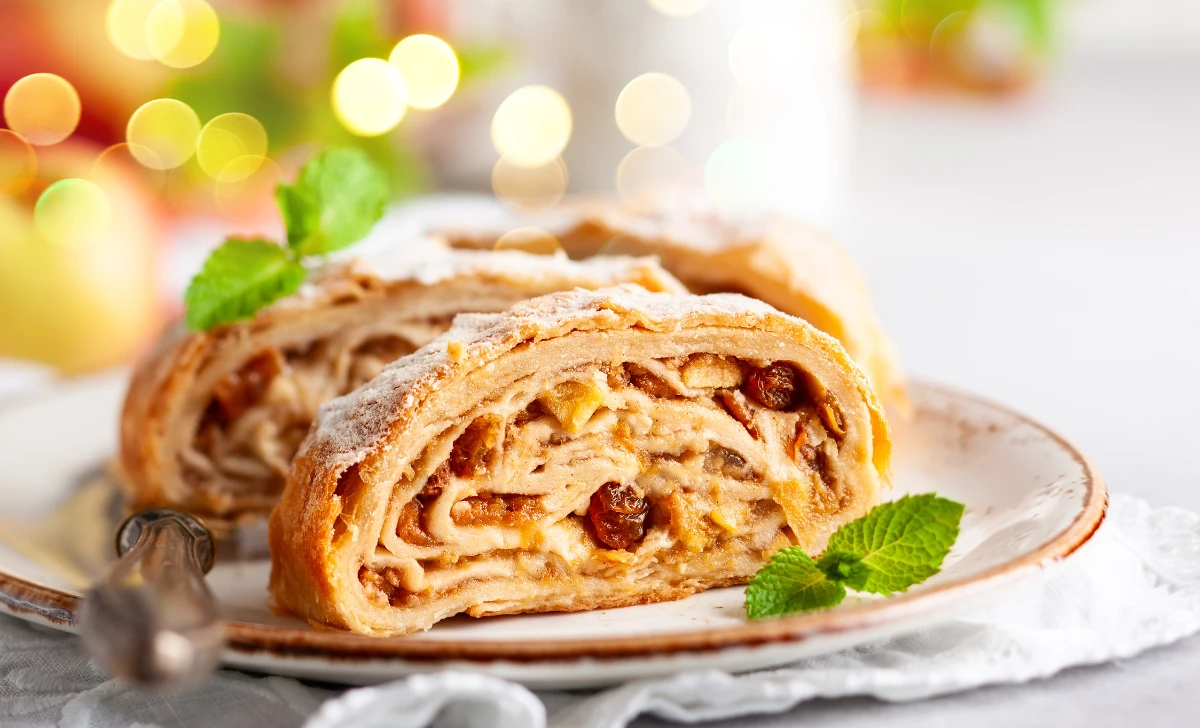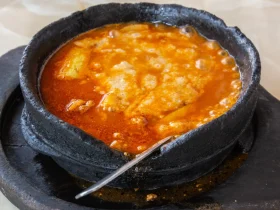There’s something utterly enchanting about the world of baking – the way flour dances through the air, the aroma of warm pastries that wafts from the oven, and the sheer delight of creating mouthwatering treats from scratch. Today, we’re diving into a timeless classic that never fails to charm both bakers and eaters alike: the strudel. This delectable pastry, with its flaky layers and delectable fillings, has been a beloved favorite for generations. Join me on this culinary journey as we explore the art of crafting a heavenly strudel that will have your taste buds dancing with joy.
[ez-toc]
History
If the pages of culinary history were a captivating novel, the story of the strudel recipe would undoubtedly be a gripping chapter. Dating back centuries, this beloved pastry has traversed time and cultures, leaving its delectable mark on tables around the world. From humble beginnings to a symbol of indulgence, let’s unravel the fascinating history of the strudel recipe.
Origins Shrouded in Mystery: Unveiling the Birthplace
As with many culinary treasures, pinpointing the exact birthplace of the strudel recipe is a challenge steeped in ambiguity. However, historical breadcrumbs lead us to the heart of Central Europe, where the strudel first emerged as a rustic delight. While Austria often takes the credit, regions across the Austro-Hungarian Empire claim their stake in the strudel’s origin story.
The Viennese Waltz: Strudel’s Austrian Affair
In the annals of pastry history, Vienna emerges as a key player in nurturing the strudel recipe into the iconic treat we know today. The Viennese bakers of the 18th century were masterful artisans, and it was in their hands that the strudel truly blossomed. The delicate art of stretching paper-thin dough to envelop an enticing filling became a Viennese specialty, captivating palates and hearts alike.
A Tale of Dough and Skill: The Art of Stretching and Thinning
At the heart of the strudel’s allure lies the mesmerizing skill of stretching and thinning dough until it’s almost translucent. This technique, which requires finesse and patience, is where the strudel earns its name. The word “strudel” itself is derived from the German term “strudeln,” meaning “to whirl” or “to swirl.” The dough, as it’s gently coaxed into thinness, dances like a graceful waltz, creating layers that will later shatter with crispness.
From Sweet to Savory: Strudel’s Flavorful Evolution
Initially, strudels were predominantly sweet affairs, often showcasing succulent fruits and nuts nestled within their delicate folds. The iconic apple-cinnamon strudel, a harmonious blend of tartness and warmth, emerged as a timeless favorite. Yet, as culinary boundaries expanded, so did the strudel’s horizons. Savory variations began to take shape, marrying ingredients like spinach, cheese, and meats with the flaky embrace of the pastry.
Cultural Wanderings: Strudel’s Global Odyssey
As the strudel’s reputation flourished, it embarked on a global journey, traversing continents and cultures with unwavering charm. European immigrants carried cherished family recipes across oceans, introducing new lands to the magic of the strudel. In the United States, Jewish immigrants brought their cherished rugelach, a delightful strudel cousin, which soon found a place in American hearts and bakeries.
Modern Twists and Creative Turns: Strudel’s Reinvention
In today’s culinary landscape, the strudel recipe continues to captivate both traditionalists and innovators. Chefs and home bakers alike experiment with daring fillings, fusing global flavors and reimagining the strudel’s very essence. Strudel dough has become a canvas for culinary artistry, inviting both sweet and savory interpretations that pay homage to the past while embracing the future.
Preserving a Delicious Legacy: Strudel’s Enduring Appeal
With each bite of a freshly baked strudel, we not only savor a symphony of flavors but also partake in a centuries-old tradition. The strudel recipe is more than a recipe; it’s a testament to the power of food to transcend time and connect us with generations past. From imperial courts to humble kitchens, the strudel’s journey has been one of resilience, creativity, and above all, sheer deliciousness.
So, the next time you indulge in a slice of strudel, remember that you’re savoring a slice of history – a history that continues to unfold with every delicate layer, every thoughtful filling, and every joyful bite. The strudel recipe is a living testament to the art of baking, the fusion of cultures, and the simple joy of sharing a scrumptious treat with those we hold dear.
Time
| Step | Time |
|---|---|
| Gathering Ingredients | 15 minutes |
| Making Strudel Dough | 30 minutes |
| Resting Dough | 30 minutes |
| Preparing Filling | 20 minutes |
| Assembling and Shaping | 15 minutes |
| Preheating Oven | 10 minutes |
| Baking Strudel | 25-30 minutes |
| Cooling and Slicing | 15 minutes |
| Plating and Serving | 10 minutes |
| Total Time | About 2.5 hours |
Please note that these times are approximate and may vary based on your experience, kitchen setup, and specific recipe variations. Enjoy your strudel-making journey!
Ingredients
| Ingredients | Quantity |
|---|---|
| All-Purpose Flour | 1 cup |
| Eggs | 1 |
| Vegetable Oil | 2 tablespoons |
| Salt | 1/4 teaspoon |
| Apples (your choice) | 2 medium |
| Cinnamon | 1 teaspoon |
| Sugar | 1/4 cup |
| Chopped Nuts (optional) | 1/4 cup |
| Phyllo or Puff Pastry Sheets | 4 sheets |
| Butter (for brushing) | 2 tablespoons |
| Powdered Sugar (for dusting) | As needed |
Feel free to adjust the quantities based on your preferences and dietary needs. Enjoy your delicious homemade strudel for two!
Directions
Step 1: Gathering Your Culinary Warriors
Before you embark on your strudel-making adventure, gather your culinary warriors – the essential ingredients that will bring this masterpiece to life.
Step 2: Crafting the Perfect Strudel Dough
Creating the foundation of your strudel is an art in itself. Follow these steps to master the perfect strudel dough:
Choosing the Right Flour for Flawless Flakiness
- In a bowl, whisk together 1 cup of all-purpose flour and 1/4 teaspoon of salt.
Mixing the Magic: Achieving the Ideal Dough Consistency
- Create a well in the center of the flour mixture and crack in 1 egg. Add 2 tablespoons of vegetable oil.
Kneading and Resting for Dough Perfection
- Gently mix the ingredients, then turn the dough out onto a lightly floured surface and knead until smooth and elastic. Form into a ball.
- Cover the dough with a cloth and let it rest for about 30 minutes, allowing the gluten to relax.
Step 3: Crafting the Filling Masterpiece
Prepare a tantalizing filling that will grace your strudel with irresistible flavor:
Traditional Apple Cinnamon Filling (Feel free to adapt)
- Peel, core, and thinly slice 2 medium apples. Toss them with 1 teaspoon of cinnamon and 1/4 cup of sugar. Add 1/4 cup of chopped nuts if desired.
Step 4: Artful Assembly and Baking
It’s time to bring your strudel to life by artfully assembling and baking it to perfection:
Stretching and Layering the Dough
- Preheat your oven to 350°F (175°C). On a clean, lightly floured surface, roll out 4 sheets of phyllo or puff pastry into a thin rectangle.
- Carefully stretch and thin the dough by gently pulling and stretching it with your hands. Aim for a large, thin sheet.
Laying the Foundation and Adding the Filling
- Brush the stretched dough with melted butter, leaving a border around the edges.
- Spoon the prepared apple filling along one long edge of the dough, then fold in the short edges and carefully roll up the strudel.
Baking to Golden Glory
- Place the strudel on a baking sheet lined with parchment paper. Brush the top with more melted butter.
- Bake in the preheated oven for 25-30 minutes, or until the strudel is golden brown and crispy.
Step 5: Savoring Your Culinary Creation
Your strudel is now ready to be savored. Follow these steps to present and enjoy your masterpiece:
Slicing and Serving with Panache
- Allow the baked strudel to cool slightly, then dust the top with powdered sugar for an extra touch of elegance.
- Carefully slice the strudel into portions and plate them with finesse.
- Serve your delicious homemade strudel as is, or with a dollop of whipped cream or a scoop of vanilla ice cream.
Step 6: Enjoy and Share the Joy
Now that you’ve mastered the art of strudel-making, it’s time to relish the fruits of your labor and share the joy of this delectable treat with loved ones. Enjoy each delectable bite and bask in the satisfaction of creating a culinary masterpiece from scratch.
Remember, the journey of creating a strudel is as delightful as the destination. Happy baking and bon appétit!
Equipment Required
Nutrition Information
| Nutrition Information | Per Serving |
|---|---|
| Serving Size | 1 slice |
| Calories | 250 |
| Total Fat | 12g |
| – Saturated Fat | 4g |
| Cholesterol | 30mg |
| Sodium | 150mg |
| Total Carbohydrates | 32g |
| – Dietary Fiber | 2g |
| – Sugars | 16g |
| Protein | 4g |
Please note that these values are approximate and can vary based on the specific ingredients and quantities used. Always refer to specific product labels or consult a nutritionist for precise information.
Enjoy your delicious strudel while keeping an eye on your nutritional intake!
Tips
- Handle with Care: When stretching the dough, be gentle to avoid tearing. If a tear occurs, don’t worry – simply patch it up and continue. Imperfections add character!
- Butter Up: Brushing melted butter on the dough layers enhances both flavor and texture. For a richer taste, consider using clarified butter (ghee).
- Keep it Cool: If the dough becomes too warm and sticky while stretching, pop it in the fridge for a few minutes to firm up before continuing.
- Mindful Rolling: When rolling up the strudel, use a gentle touch to prevent the filling from squishing out. A sushi rolling mat can be a handy tool for this step.
- Golden Glory: Achieve that perfect golden hue by brushing the top of the strudel with egg wash (1 beaten egg mixed with a splash of water) before baking.
- Slice with Finesse: To achieve clean slices, use a sharp, serrated knife. A gentle sawing motion works wonders.
Pros & Cons
| Pros | Cons |
|---|---|
| ✔️ Delightful blend of flavors | ❌ Requires some dough-handling skill |
| ✔️ Versatile – sweet or savory | ❌ Longer preparation time |
| ✔️ Impressive presentation | ❌ Higher calorie and fat content |
| ✔️ Creative fillings and variations | ❌ Potential for dough tearing |
| ✔️ Culinary tradition and history | ❌ Contains sugars |
Conclusion
As we come to the end of this delectable journey into the world of strudel making, it’s evident that there’s more to this pastry than meets the eye. What began as a simple dough and a handful of ingredients has transformed into a symphony of flavors, textures, and creativity that’s yours to command. The art of crafting a strudel is a testament to the joy of creating something beautiful and delicious from scratch.
From the delicate dance of stretching dough to the burst of flavors in each bite, every step in this recipe is an invitation to explore your culinary prowess. Whether you choose the timeless sweetness of apple cinnamon or venture into the realm of savory surprises, your strudel creation is a canvas for your imagination to roam freely.
The journey itself is as rewarding as the destination. Embrace the flour-dusted countertops, the fragrance of baking, and the anticipation of slicing into your masterpiece. It’s a journey that connects you with culinary traditions, indulges your taste buds, and ultimately brings smiles to those lucky enough to share in the experience.
So, gather your ingredients, don your apron, and let your kitchen become a stage for culinary magic. With a little practice, a sprinkle of patience, and a dash of creativity, you’re poised to create a strudel that’s not just a recipe, but a cherished memory in the making.
Remember, the culinary arts are a canvas of discovery, and this strudel recipe is your blank slate. With each stretch of dough and each layer of filling, you’re painting a masterpiece that speaks to your heart and nourishes your soul.
So, why wait? Dive into the joy of strudel making and unleash your inner baker. Whether you’re savoring it alone or sharing it with loved ones, your homemade strudel is a work of art that reflects your unique style and passion for creating culinary wonders. Bon appétit and happy baking!
Indulge in the art of strudel making today – your taste buds and heart will thank you!
Facts
- Fact 1: 🕰️ A Time-Tested Tradition
- Did you know? 🤓 The art of stretching strudel dough dates back to the 17th century. Legend has it that Austrian bakers would challenge apprentices to stretch dough so thin that a love letter could be read through it. Talk about turning baking into a captivating romantic pursuit!
- Fact 2: 🌍 From Habsburg Kitchens to Hollywood Classics
- Movie Magic! 🎬 Strudel made its way to Hollywood stardom in the iconic film “Inglourious Basterds.” In one unforgettable scene, the strudel becomes the focal point of tension and humor. Who knew a pastry could steal the show alongside Tarantino?
- Fact 3: 🇪🇺 A Multinational Delight
- Culinary Diplomacy 🍴 The strudel’s journey mirrors Europe’s rich tapestry. It’s known as “strudla” in Croatia, “štrudla” in Serbia, and “sztrúdli” in Hungary. Its cross-border popularity makes it a delicious symbol of unity and diversity.
- Fact 4: 🎨 Art in Every Layer
- Layers of Love ❤️ Strudel-making is an art form that requires not only skill but also storytelling. Each layer of stretched dough holds memories, experiences, and culinary dreams – transforming baking into a canvas for creativity.
- Fact 5: 🌱 Sweet and Savory Surprises
- Flavors Collide! 🍏🧀 The strudel has evolved beyond sweet treats. In Austria, spinach and feta strudel (spinatstrudel) showcases a savory side. It’s a playful reminder that strudel is a versatile masterpiece, open to endless culinary experiments.
FAQ’s
Can I use frozen puff pastry instead of making the dough from scratch?
Absolutely! Using frozen puff pastry can save time and effort. Thaw it according to the package instructions and proceed with the recipe as directed.
Can I make the dough ahead of time?
Certainly! You can prepare the strudel dough in advance, wrap it tightly in plastic wrap, and refrigerate it for up to 24 hours. Allow it to come to room temperature before rolling it out.
Can I freeze the unbaked strudel?
Yes, you can freeze the unbaked strudel before baking. Wrap it well in plastic wrap and then in aluminum foil. When you’re ready to bake, simply place it in the oven directly from the freezer and adjust the baking time slightly.
What can I use instead of apples for the filling?
You can get creative with your filling! Try using pears, berries, cherries, or even a combination of fruits for a unique twist. Just make sure to adjust sweetness and spices accordingly.
Can I make a gluten-free version of this strudel?
Certainly! Look for gluten-free puff pastry or dough options at your local store. Experiment with alternative flours to make your own gluten-free dough, ensuring it’s pliable and easy to work with.
Is there an eggless option for the strudel dough?
Yes, you can replace the egg in the dough with a flax egg (1 tablespoon ground flaxseed mixed with 2.5 tablespoons of water). The texture might be slightly different, but it’s a suitable substitute.
What’s the best way to reheat leftover strudel?
To reheat leftover strudel, place it in a preheated oven at 325°F (165°C) for about 10-15 minutes until warmed through and the pastry regains its crispness.
Can I make mini strudels instead of one large one?
Absolutely! Divide the dough and filling into smaller portions to make mini strudels. Adjust the baking time accordingly, as they might bake faster.
Can I add raisins or dried fruits to the filling?
Of course! Raisins, dried cranberries, or chopped dried apricots can add delightful bursts of sweetness to your filling. Soak them in warm water or juice before adding for plumpness.
Can I use vegan butter for brushing the strudel?
Yes, you can use vegan butter or a plant-based oil for brushing the strudel dough. It will still provide the desired texture and flavor to your pastry.












Leave a Review